On Monday we roadtested some recipes from Simon Bryant’s new cookbook, Vegetables, Grains & Other Good Stuff, in a bid to find the best one. Five of our staff selected recipes and Simon himself came in to taste their dishes.
Here are the results.
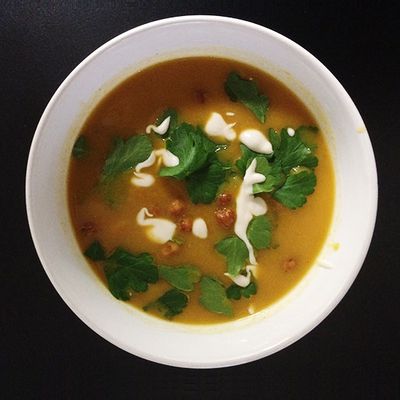
Stella Charls made Pumpkin, Chickpea and Tahini Soup (pg. 224):
We’ve just come through the middle weekend of MIFF (I’m a bit of an addict), so I’m finding my free time fairly limited and I needed to choose something from Simon’s book that was quick and easy to prepare, but hopefully still super tasty. Soup seemed achievable – pop everything in a pot and whizz it up with a stick blender? Yes please.
Simon’s recipe takes your standard pumpkin soup and gives it a North African flavour. The pumpkin pieces are coated in a ras el hanout spice blend and baked in the oven, then added to a pot of onion and chickpeas and blended together. It’s that simple. Simon also advises serving the soup with paprika chickpeas baked until they’re crispy, for added texture, and drizzled with a lemon tahini.
I found the recipe almost fool proof – only mistake I made was using canned chickpeas instead of dried but still adding the advised amount of water, which left the soup a little too thin. I will definitely amend this next time.
Judges’ comments: An absolute knock out. Beautifully presented, strong colours, gently spicy. We were so very taken by the flavours in this soup with the paprika dusted chickpeas and tahini dollop really topping it off.
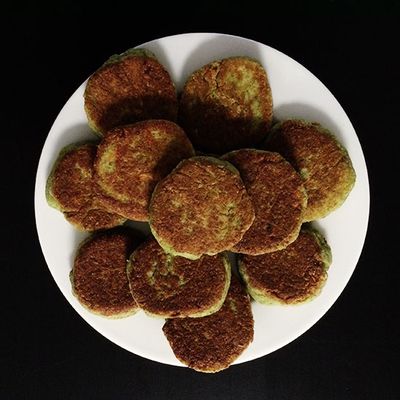
Jan Lockwood made Broccoli and Gruyere Fritters (pg. 192):
Any recipe that involves simply throwing all the ingredients, except the squeeze of lemon to serve, into a food processor and pulsing gets my vote. That’s the one for me, I thought. So really, laziness drove my decision, I’m ashamed to say.
Though the recipe certainly weren’t as simple as I’d imagined (and hoped), it was enjoyable, even fun, to make these fritters at 10pm on Sunday night (which, after taking the slooooow train home from twilight footy where my beloved Saints had been thrashed by Freo, is saying something). The instruction to use ‘floured hands’ to make the patties was absolutely necessary as the mixture is very sticky. Luckily, I don’t mind getting a bit messy. I definitely overestimated what 6cm is (it’s not that much!) and so my patties ended up looking like giant green cookies; I realised my sizing error when I got only 12 patties instead of the expected 16. The whole exercise took about 50 minutes, but I am notoriously slow in the kitchen as I invariably keep going back over the recipe to check I’m following it correctly.
Before packing the fritters away for transporting to the office the next morning, I shaved a piece from one of the (biggest) finished fritters so we could have a sneaky taste. Hubby and I agreed that these could be a very nice starter for an Indian meal, thanks to the hint of cumin. Next time I will make the patties a bit smaller and less uniform so they look more rustic.
Judges’ comments: Simple, clean, unfussy in appearance, and utterly yummy to taste. Very more-ish. These would really impress your guests at a dinner party and would be even more perfect with a little cucumber dip.
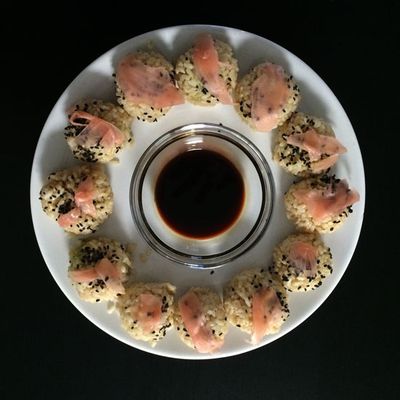
Bronte Coates made Sesame, Avocado and Cucumber Rice Balls (pg. 19):
I selected this recipe because my past self thought they would be good to serve cold the next day and also, relatively easy to transport. Ho ho ho, says my future (wiser) self.
While I found it a little tricky to track down all the ingredients (such as sake, kombu, pickled daikon with no MSG) and had to use some of the substitutions Simon had recommended instead (such as wasabi paste instead of horseradish), I found the actual making of the dish extremely straight-forward. You flavour and cook the rice with kombu, then mix through a sweet dressing. You also mash up some avocado, cucumber and things for the filling. Then, using a plastic sheet, you spread the rice into the centre, dot with the avocado filling, and pull the corners of the plastic up to shape the rice into a ball.
It took me a while to get the sizing right but I was surprised how easy it was to shape the rice into balls this way. They also seemed quite stable to me… until the next day when I opened up my carefully packed plastic containers and discovered several balls had exploded. (My colleagues comforted me by describing them as deconstructed rice balls.) I managed to save a few which I carefully laid out on a plate but even attempting to pick one of these up soon proved fraught; they had a tendency to explode in your fingers.
Still, I found this dish surprisingly flavoursome given its simplicy and as I now have all ingredients, I’ll definitely make again. Though, I’ll probably just be transporting them from the plate to my mouth.
Judges’ comments: Sophisticated and refined in appearance, and wonderfully chewy to eat. These rice balls looked so simple and yet were a mouthful of complex, delicate flavours. They almost tasted as though there could have been some fresh salmon or kingfish in them.
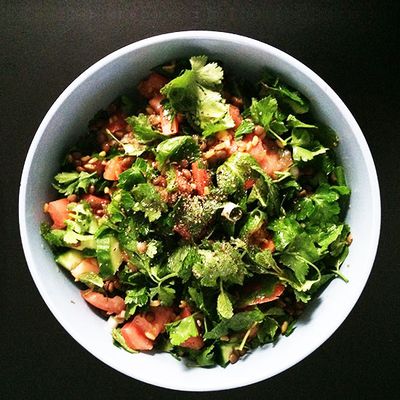
Alan Vaarwerk made Freekeh and Lentil Tabouleh (pg. 22):
I’ve never been a big fan of tabouleh, mostly because I’m not crazy about parsley – but the continental version used in this recipe takes away some of the bitterness and feels less like you’re chewing on a garnish. It was so easy to make – just simmering the lentils and freekeh in a saucepan to soften them up, chopping up everything else and chucking it all together before serving.
In fact, the hardest part of the whole process was tracking down freekeh. I couldn’t find it anywhere in the CBD, so advise you head out to a suburban grocer or wholefoods store (or a supermarket with a large health-food section) to avoid any Saturday night supermarket freekeh-outs (sorry).
Simon makes mention in his notes of the need for an extremely sharp knife – I thought my knives weren’t too bad, but in the end my tabouleh ended up being a little chunkier than planned – not that I minded.
Judges’ comments: Bright, healthy and full of greens with a crunchy burst of freshness and vibrancy to taste. Eating this dish just feels so good for you. Nothing’s bruised, nothing’s soggy – a great texture.
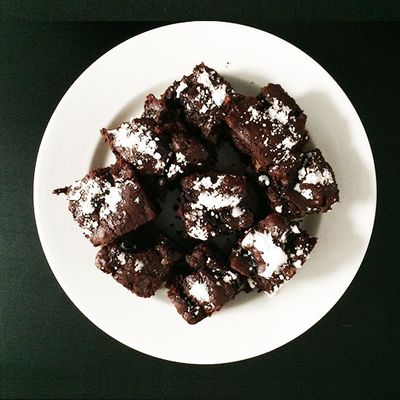
Chris Gordon made Cocoa, Lentil and Spelt Brownies (pg. 168):
I love to bake. I love to bake dense, syrupy cakes that work at the end of the meal or the start of the day. And so it is with brownies – they can be as delicious with morning coffee as they are with a dollop of cream in the eve. I’ve made so many brownies in my time that it is actually ridiculous and I don’t need to follow a recipe anymore. But I did for these because Bryant’s recipe for brownies includes lentils. At least half a cup worth of mushed brown lentils, all mixed in with eggs, sugar, butter and cocoa. The end result is a bundle of goodness that is less sweet and also, perhaps a little more moist.
I followed his recipe to the tee the first time round but the next time I added a little more sugar and cooked them this side of 20 minutes, in a very hot oven. As desired, they worked well in the morning, and also when the sun went down. And also at lunch. Also good for morning tea too now I think about it…
Judges’ comments: Oooh la la, these were really special. Impressive and decadent to look at and moist, yet crumbly, chocolate goodness in flavour. Not too sweet or rich or heavy, these somehow felt healthy and would be ideal with a raspberry coulis drizzled over the top.
And… the winning dish (as selected by Simon himself) was Sesame, Avocado and Cucumber Rice Balls. Though Simon did say this was in part due to him being a brown rice fiend.
During the lunch, we really loved hearing Simon talk about food and food culture. Here were some of our favourite takeaways from the lunch:
- Good chefs can’t culturally surf. They have to truly immerse themselves in the culture to give food the attention it deserves.
- No, we are NOT what we eat.
- Some chefs that inspire him are Anthony Myint and Jennifer McLagan.
- Simon’s favourite recipe in Vegetables, Grains & Other Good Stuff is Hot Pot with the Lot (pg. 195). He’s pretty sure he likes all of them though.


